“Let’s talk turkey” is an American expression that means to discuss a topic frankly and honestly. This is exactly what this topic aims to achieve. Meat consumption trends suggest Americans consume an estimated 254 lbs of meat annually, but no other meat source has such a significant cultural impact as the traditional turkey.
Here’s an in-depth look at the sad lives of turkeys raised for the slaughterhouse.
How Many Turkeys Are Killed Each Year
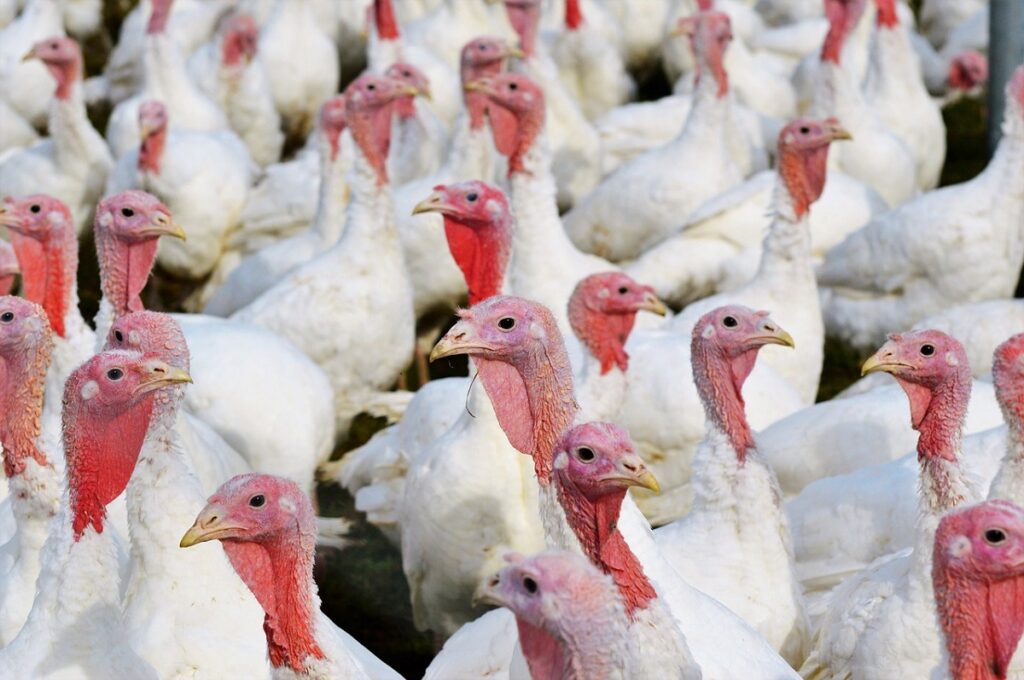
Turkeys are an integral food source vital to many small holding farms globally. According to Compassion in World Farming, National Turkey Federation data estimates Americans produce and consume 216.5 million turkeys, while globally, it’s risen to 630 million.
Many Americans believe turkey was part of the original harvest meal served in October 1621, but that is historically inaccurate. The average turkey raised worldwide lives for a handful of months.
In 2021, Nearly 601 Million Turkeys Were Killed Around the World. (FAO)
The FAO (Food and Agriculture Organization of the United Nations) estimates the chickens’ cousin, the turkey, has become a worldwide favorite since Spanish traders exported domesticated wild turkeys and introduced Europeans and Asians to the delicate meat in the 16th Century.
In the United States, 250 Million Turkeys Are Slaughtered Each Year. (Farm Sanctuary)
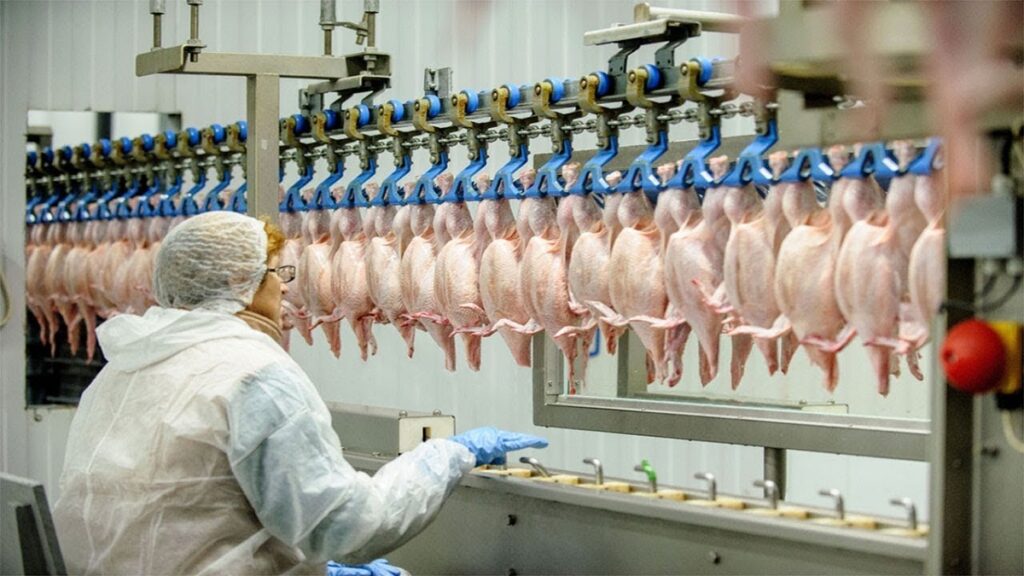
250 million!! That’s a lot of turkeys killed, and the figure suggests that 75% of Americans annually consume an entire turkey.
Sadly, 99% of all turkeys are raised on inhumane factory farms and in similar cruel conditions as 34.4 billion chickens.
Factory-farmed turkeys endure these abuses:
- Painful expedited growth
- Genetically manipulated, mutilated, and debeaked
- Crowded facilities, short life
- Not protected under the Humane Methods of Slaughter Act
In 2023, 214,508,816 Turkeys Had Been Killed in the US. (Animal Kill Clock)
That figure changes by the minute, and to keep abreast of the consequences of factory farming stats, check out these Kill Clock figures.
In the UK, 15,400,000 Turkeys Had Been Killed in 2023. (Animal Kill Clock)
Although turkeys aren’t native to the United Kingdom, they have been part of the British dinner table at Christmas since the 17th century.
In Canada, 19,234,250 Have Been Killed Up Till Now. (Animal Kill Clock)
Canadians celebrate seasonal holidays like Easter, Thanksgiving, and Christmas by serving the iconic turkey and stuffing dinner.
In the US, 46 Million Turkeys Are Killed Each Thanksgiving. (PETA)
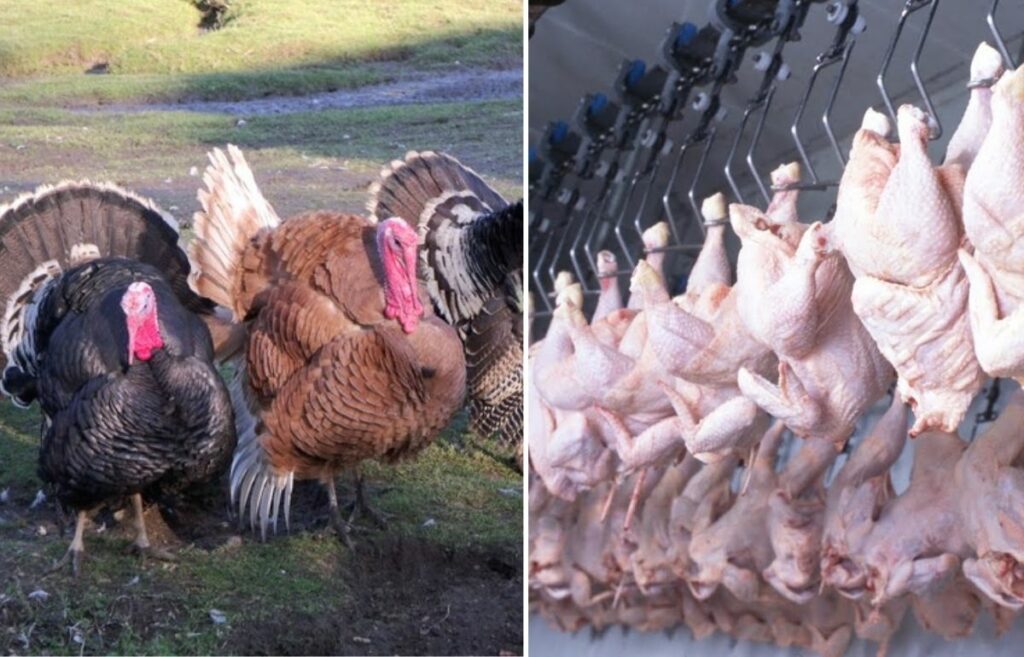
According to statistics, Thanksgiving is the most celebrated holiday in the USA. Although turkey wasn’t part of the first traditional Thanksgiving event (more likely venison, geese, and duck), turkey has surpassed other poultry meat.
PETA strongly supports a tofurky tradition instead.
Every Year, 88 Percent of Americans Eat Turkey for Thanksgiving. (NTF)
Since turkey is part of American tradition, 99% of those birds come from industrial farming facilities and processing plants that forgo the humane treatment of these beings.
In the US, the Per Capita Consumption of Turkey in 2023 Will Be 15.3 Pounds. (USDA)
The United States Department of Agriculture (USDA) report suggests that meat production will decline in 2023 for the first time since 2014. Turkey prices rose after consumption dropped, but it’s expected to rebound in 2023. Exports are lower, production increased by 6%, and imports will grow by 41% to meet demand.
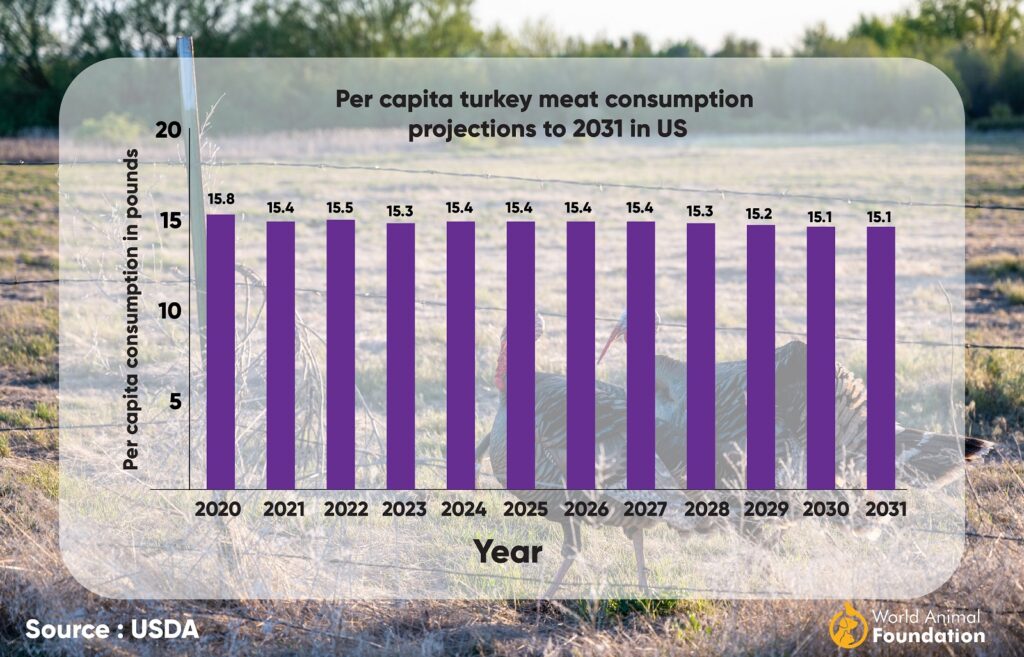
Turkeys Are Slaughtered When They Are 5 to 6 Months Old. (Humane Action)
Industrial-farmed turkeys never meet their mothers. They live in confinement and are genetically engineered to meet industry standards. In contrast, wild turkeys live up to 10 years, and hens form a strong mother-to-chick bond.
Female Turkeys Are Considered Ready for Slaughter at 14 to 16 Weeks Old and Males at 19 Weeks Old (Media Science)
Many animals are bred for slaughter, and turkeys and chickens on factory farms have a torturous existence. Factory hens are forced to lay between 100 and 130 until their reproductive systems wane. The eggs get shipped to hatcheries. Hens are transported to the slaughterhouse at 3 to 4 months, and males at shy of 5 months.
Turkeys Can Live for up to Ten Years in the Wild if Not Slaughtered. (Humane Action)
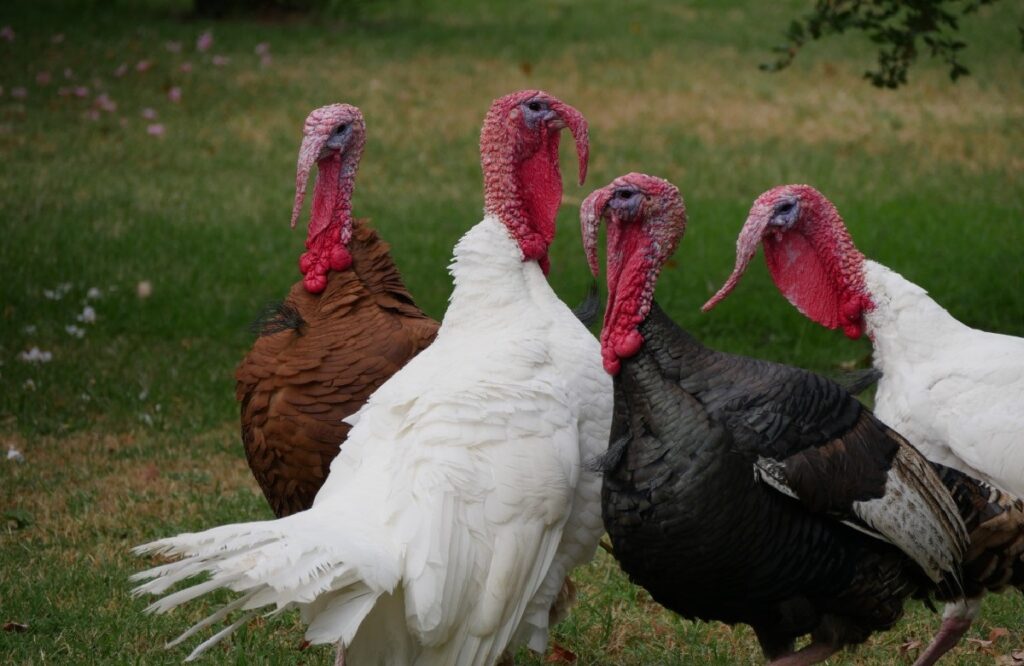
The startling life expectancy of farmed turkeys versus wild turkeys is significant. A wild turkey, though faced with natural predators, can live for up to ten years.
Turkeys Raised in the United States in 2023 Are Expected To Be 219 Million. (USDA)
Although the Avian Influenza impacts poultry and egg production, factory farms in the USA still bred over 219 million turkeys. The Highly Pathogenic Avian Influenza (HPAI) or bird flu has strangled poultry and egg farmers, and the 2022 outbreak of H5N1 affected nearly 59 million birds and set record egg and turkey prices.
Minnesota, With 39.0 Million Turkeys, Is the Top Turkey-Producing State. (USDA)
Minnesota is a farming state. It ranks as number 1 for turkey farming among the six states, producing 68% of all turkeys raised in the USA. Minnesota turkey production rose by 4%, while Arkansas and Missouri gained 6%.
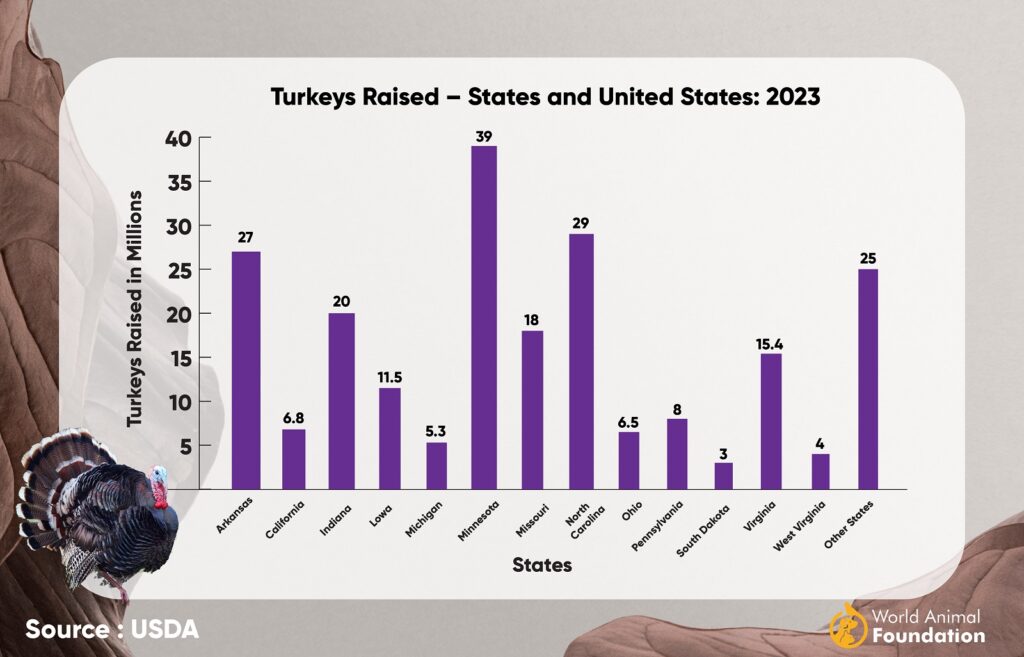
US Turkey Meat Production Was 4.11 Billion Pounds From January to September 2023. (USDA)
According to the USDA, turkey meat production was 4.11 billion pounds—up 5% over the previous year.
Turkey production in dollar value:
- 2018—3.79 billion
- 2020—5.17 billion
- 2022—7.10 billion
Turkey Shortage Due to Avian Flu
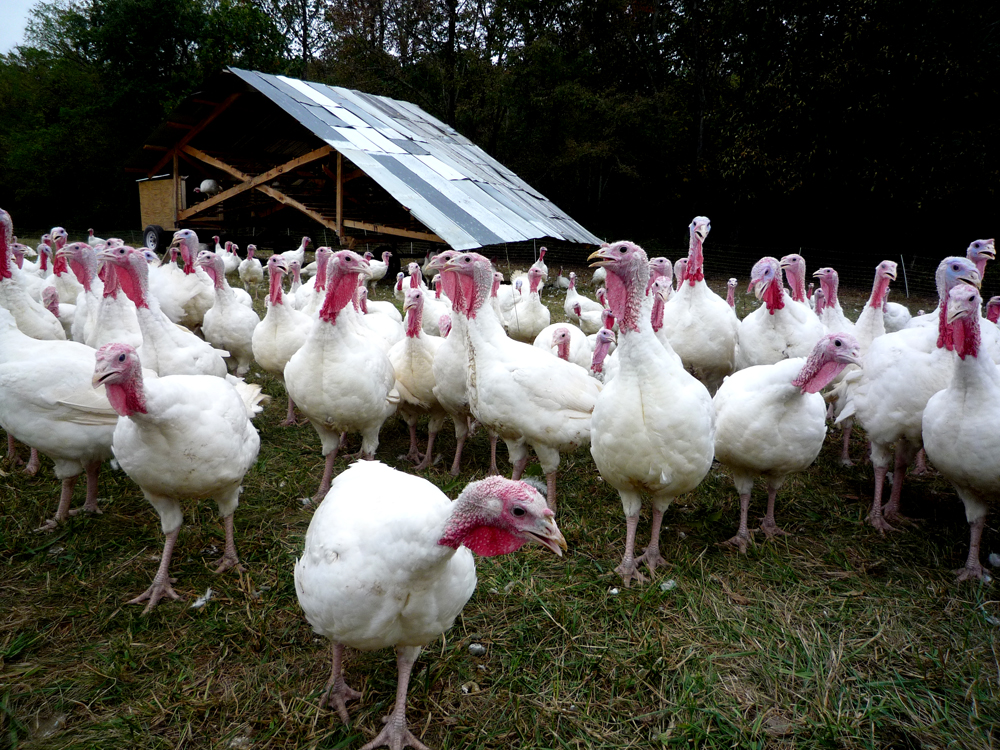
Despite the ravages of the Avian flu, American families still consumed 45 to 46 million turkeys this Thanksgiving Weekend with a helping of apple pie.
Avian flu has been found in over 150 different species of wild birds and infects millions of farm poultry. Since the last outbreak, over 5 million turkeys, chickens, and ducks perished from the bird flu.
These facts are daunting and graphic, and aside from Avian flu, farmed turkeys may die from these causes:
- Crippled from genetically manipulated contributions, heart attacks, and organ failure
- Starvation
- Deformed legs and joint pain
- Dehydration
- Small chicks are ground up in a mill (while alive)
- One million (estimated) are boiled alive
- Crammed quarters
FACT: Turkeys on farms seldom die from old age.
A Record-Breaking 62.76 Million Birds, Including Turkeys, Died in the US Due to the Avian Flu. (USDA)
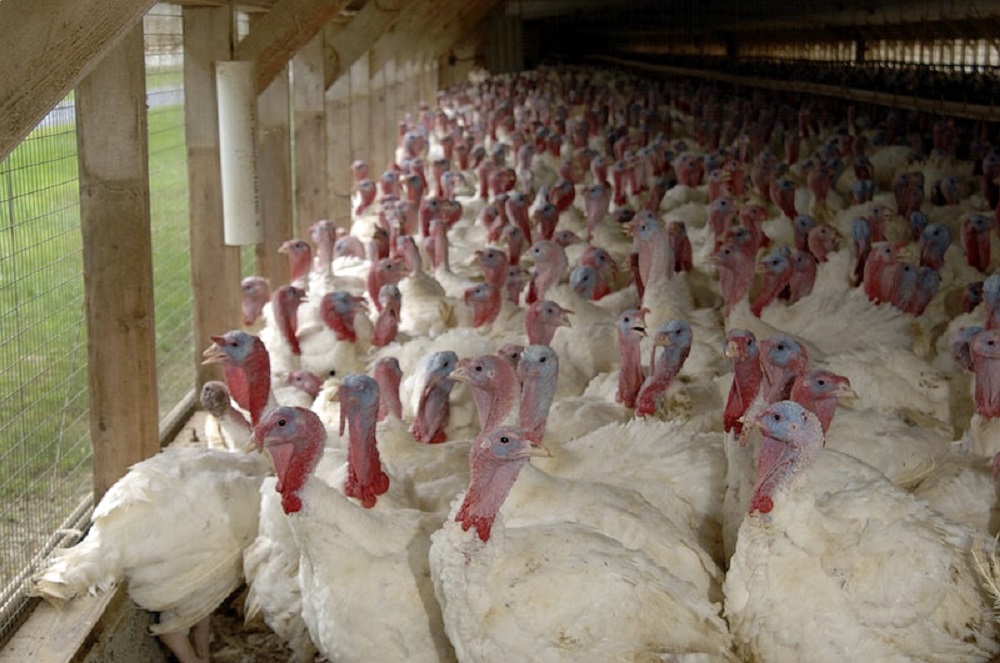
The Avian flu has crippled fowl populations since it was first recognized in Italy in 1878, killing chickens. The disease infects the bird species’ respiratory, gastrointestinal, nervous, and reproduction systems, and there are several strains (H5N1, H7N3, H9N2, etc.). Avian flu has cost producers over 757 million, according to a USDA estimate.
It’s important to note that these numbers repeat yearly.
In 2022, Because of HPAI Exposure, 5.4 Million Turkeys Were Depopulated in the Turkey Industry. (USDA)
Avian flu can decimate farm poultry and wild bird populations. Depopulation methods cull poultry to prevent the spread of HPAI. Depopulation is a strategy used on other farm animals when disease strikes. The AVMA (American Veterinary Medical Association) defines depopulation as a fast and effective measure to destroy infected animal populations.
Turkey Facts
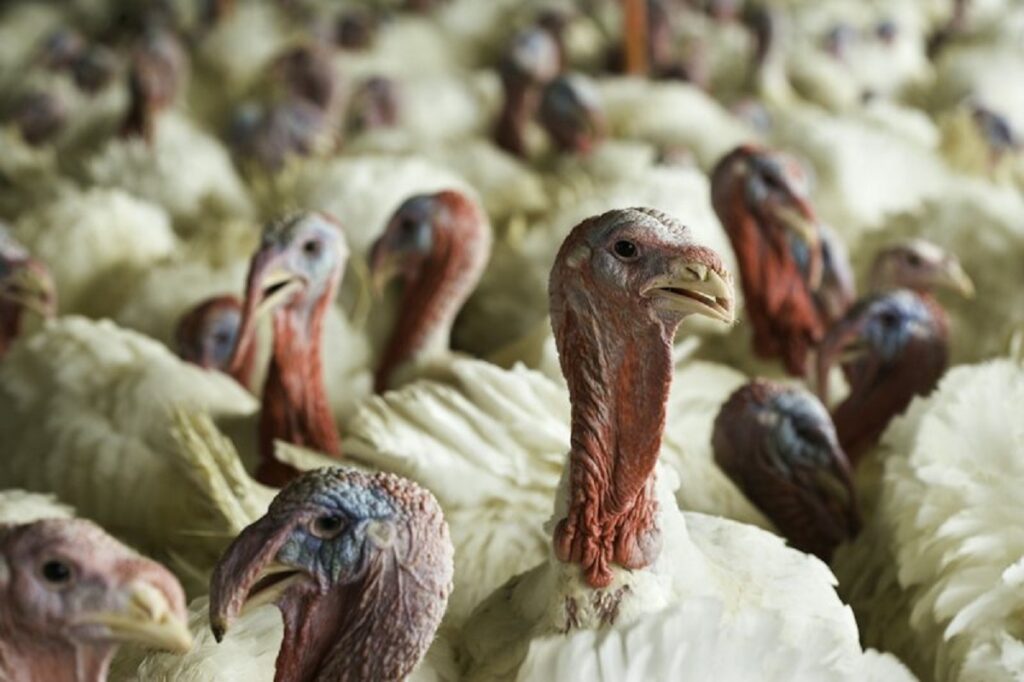
FACT: Turkeys are sentient beings.
Large Incubators Are Used To Hatch Baby Turkeys in the Shed. (Global Animal)
Active laying hens produce eggs that never hatch from their body heat. Eggs are moved on a conveyor belt to incubator stations, then hatched and transported to a farm shed overpopulated with thousands of other chicks.
Turkeys Live in a Shed With Thousands of Other Turkeys (MSPCA)
The American National Turkey Federation claims their farmers raised over 210 million turkeys on 2500 farms. ANTF paints a pretty picture, but these shed or grower houses are often windowless structures, and these densely populated sheds leave little room for turkeys to spread their wings.
Turkeys Spend All of Their Lives in a Shed (PETA)
Turkeys live in dim sheds and have limited space to move. Each bird has about 3.5 sq ft of room.
Turkeys Are Genetically Modified To Grow Quickly (Harvard)

At WAF, we’re not making up these facts and figures. Iconic institutions support these facts and prove that turkeys and farmed broiler chickens are genetically engineered to maximize a return on profit. And remember, poultry doesn’t even get minimal protection under the United States Department Animal Welfare Act.
Fact: Farmed turkeys are called “Broad Breasted White.” A wild turkey breast is brownish.
Male Turkeys Are Raised to a Live Weight of 41 Pounds on Average. (USDA)
Turkey dinners are a status symbol in America. The bigger the turkey on the platter, the better. Toms and hens are fed growth hormones, and one study found that if we fed a seven-pound baby at the same rate as a factory turkey, it would weigh 1500 lbs at 18 weeks.
Turkey’s legs commonly break due to artificial manipulation (PETA).
Barbaric is one word to describe this harrowing fact. While artificial manipulation is just one way that factory farm turkeys suffer, many farm animals endure cruelty from farm workers.
Baby Turkeys Never See Their Moms. (PETA)
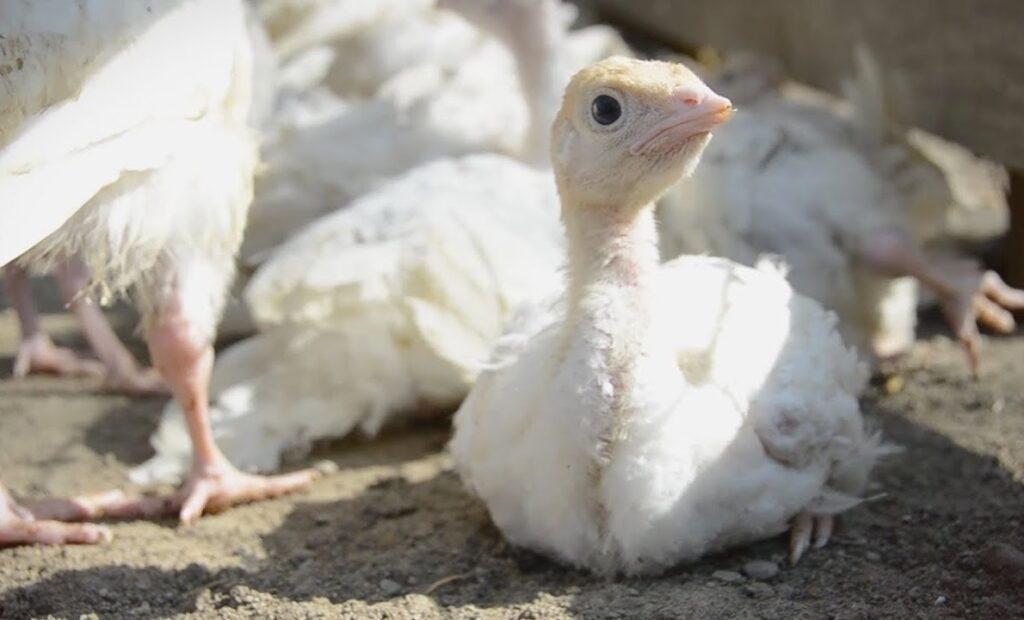
Chicks are hatched under a heat lamp in an incubator and never meet their mother, who is forced to churn out an unnatural number of eggs until she stops producing. Watch this wild turkey mom with her chicks.
Turkey Can Run 35 Miles per Hour and Fly 55 Miles per Hour. (PETA)
Yes, turkeys can fly, and they’re surprisingly fast. Turkeys have a keen intelligence and are highly affectionate, and they don’t mind crooning to their favorite tunes.
To Prevent Turkeys From Fighting, Their Toes and Beaks Are Amputated. (Farm Sanctuary)
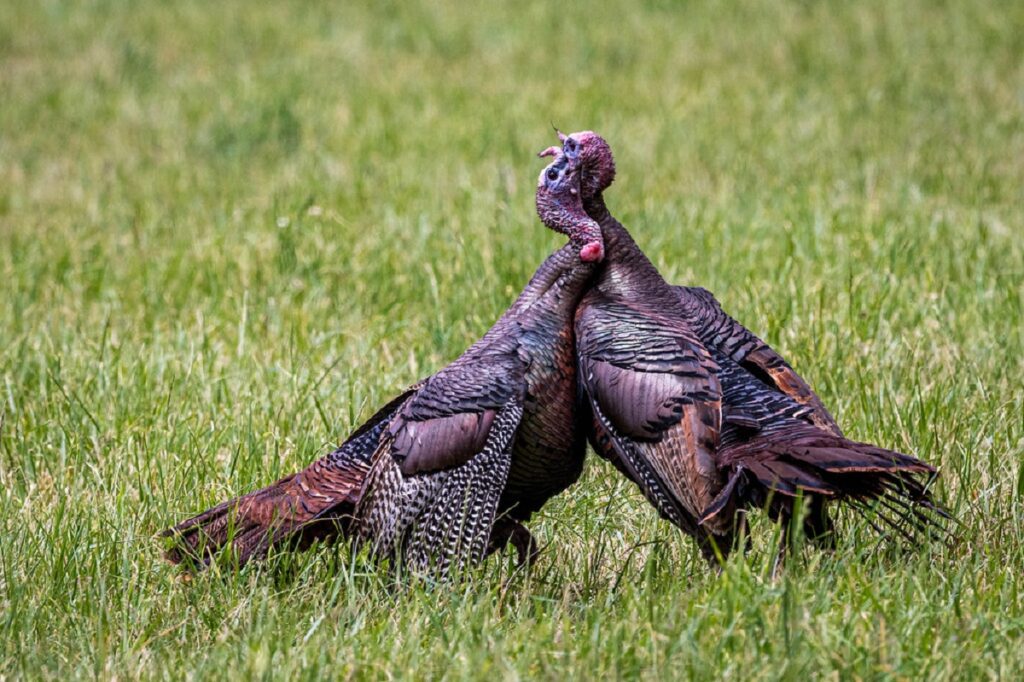
It’s hard to imagine, but there’s a job where someone amputates 260 million turkey beaks and toes. Actually, that’s times eight toes per turkey.
Many Farms Allow Staff To Treat Turkeys Any Way They Choose. (PETA)
Watching footage of how some farm workers treat turkeys is heartbreaking. What goes on in the turkey trade, with video footage to prove it, is senseless violence and astonishing.
How Do They Kill Turkeys
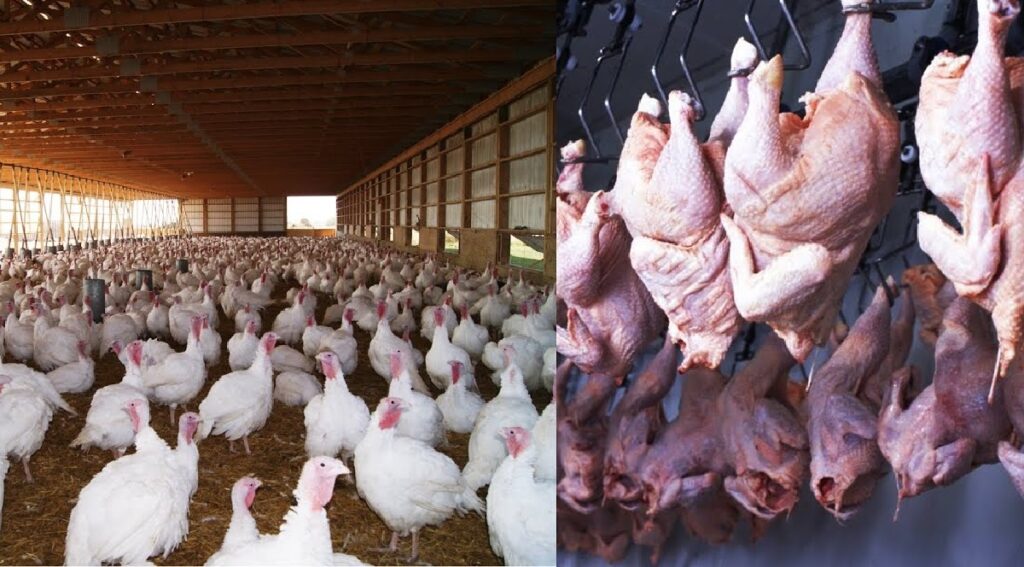
The lives of domestic factory turkeys are cruel and harrowing.
The Transportation Period for Turkeys Can Be up to 28–26 Consecutive Hours. (Cornell Law School)
Fact: Birds express fear and stress.
Their upbringing significantly impacts their well-being during transport and preslaughter.
During transport, turkeys encounter new variables like motion, vibration, daylight, noise, and temperature extremes inducing further stress symptoms. The industry tries to mitigate these stressors as they have a substantial monetary impact on the quality of the poultry, according to Weeks and Nicol, 2000.
The Trucks That Transport Turkeys to the Slaughterhouse Sometimes Crash. (PETA)
Since a typical turkey transporter carries as many as 2000 birds, a single accident has grave consequences. Turkeys also die in transport from fluctuating temperatures and suffer heat exhaustion or freezing to death.
Turkey’s Legs Commonly Break When They Are Hung Upside Down in the Slaughterhouse (CIWF)
Although we don’t think of turkeys as fragile, these sensitive creatures are already prone to physical injuries at the slaughterhouse and don’t fare well when they’re hung and immersed in the stunning tank.
Fact: Next time you buy a turkey that isn’t Grade A—you now understand what happened to the bird at the farm or slaughterhouse.
Turkey Heads Are Dipped in Electrified Water To Kill Them. (UPC)
An estimated 260 million turkeys are killed annually. Many survive the stunning tank and get scalded alive in the electric water bath.
Turkeys Are De-Feathered by Drowning Them in Boiling Water. (PETA)
It’s true! The scalding hot water makes it easier for the feathers to come off without damaging the skin. Newer methods also include steam, but sadly, many turkeys end up in boiling water alive when the process begins.
Turkeys Can Regain Consciousness Before Being Boiled Alive, According to Poultry Specialists. (MPDI)
Poultry processing plants operate on a tight schedule to process millions of animals. Efficiency is vital, and many plants are automated. Mistakenly, millions of turkeys are killed by being boiled alive before being properly stunned and meeting the automated blade.
Where Are Turkeys From
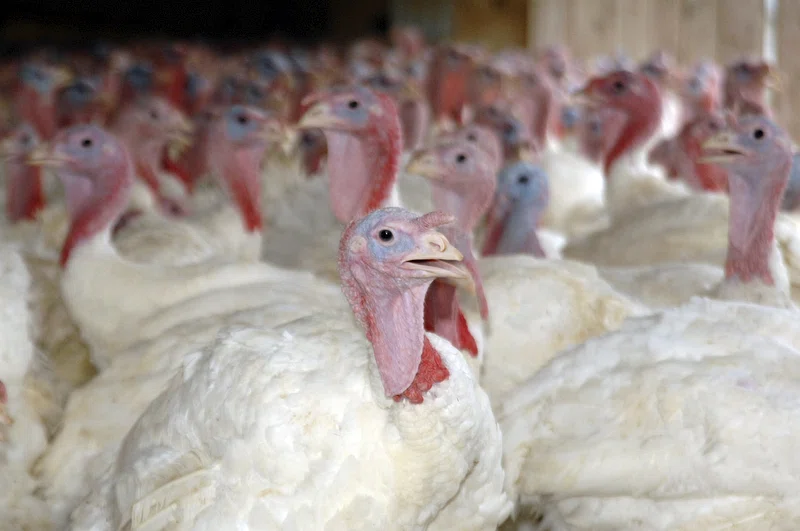
Domesticated turkeys are strongly tied to indigenous history, but it wasn’t until the Europeans arrived that we began exploiting this bird and mass farming.
Domestic Turkeys Are Descended From the American-Only (Meleagris gallopavo) Wild Turkey Almost 11 Million Years Ago. (NCBI)
Humans started domesticating these birds thousands of years ago. Selective breeding changed the dynamics of their appearance. To date, turkeys are the second most important poultry food source.
The Other Species Is the Mexican and Central American, Which Is Ocellated Turkey (Meleagris ocellata). (All About Birds)
The Ocellated turkey has magnificent plumage. Iridescent shades of blue, green, bronze, and powder blue heads make this bird unique. It has red and orange fleshy nodules and whistles instead of clucking and gobbling.
Turkey Facts for Kid
- Male turkeys are known as toms, and females are known as hens.
- Male and female turkeys both gobble.
- Wild turkeys can fly.
- Turkeys have greater vision than humans.
- They can alter the color of their heads based on their emotions.
- Benjamin Franklin chose the turkey above the bald eagle.
FAQs
Turkeys deserve to be treated with kindness and gentleness.
Approximately How Many Turkeys Are Eaten Each Year on Thanksgiving in the United States?
Americans consume between 45 and 46 million turkeys on Thanksgiving Day.
How Long Do Turkeys Live?
Wild and domestic turkeys can live up to 10 years, but 4 to 5 years is more likely. Factory-farmed turkeys live on average only up to 14 weeks.
Are Thanksgiving Turkeys Male or Female?
Both male and female turkeys grace our dinner tables, but it is more likely that it’s a hen, not a tom.
What Color Is a Turkey’s Beak?
The beak is often yellow, though it can be brown or black.
How Many Feathers Does a Grown Turkey Have?
Turkeys have between 5000 and 6000 feathers.
How Big Do Turkeys Get?
Turkeys are the largest game fowl in America; hens weigh 8 to 12 lbs, and toms weigh up to 41 lbs.
Conclusion
In celebration of Thanksgiving Day, Americans consume 45 to 46 million turkeys—a species native to North America, in one meal. Worldwide, 630 million turkeys killed become part of the dinner table. However, it doesn’t mean we have to treat this animal so poorly.


